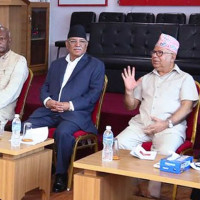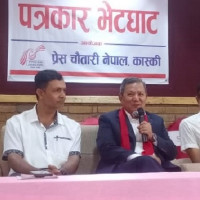- Saturday, 23 August 2025
Crucial Irrigation Project
Nearly 65 per cent of Nepalis still depend on agriculture for their livelihood. However, the contribution of agriculture to the economy is less than 25 per cent. Despite successive governments having prioritised the sector, many farmers don't find it appealing enough to labour in the field. The lack of timely availability of pesticides, the dearth of modern tools and innovative practices, the scarcity of inputs, among other factors, all limit the agricultural yield, keeping the sector from becoming profitable enough to incentivise the new generation to continue it.
There is one more recent nightmare that farmers worldwide dread the most: drought, which has grown in duration and frequency as a result of climate change. In an arid land with scant or no irrigation facilities and highly reliant on rainfall to cultivate crops, the threat can be real and overwhelming. It's an irony, however, that a country like Nepal, where a good number of perennial rivers and rivulets cut through the country, a prolonged drought in a bread basket region can deal a devastating blow not only to farmers there but also to the food security of the entire nation. That's because our agriculture is overly rainfall reliant, and the staple crops are highly water-intensive.
Against this backdrop, there is something to be sanguine about, though. Several game-changing irrigation projects are underway nationwide. Prime Minister KP Sharma Oli on Tuesday inaugurated the extended irrigation facilities, hydro power, and transmission line of the Rani Jamara Kulariya Irrigation Project in Kailali district. This marks the completion of the project’s second phase and extension into the third one. Started with the collective effort of local farmers using traditional skills some 120 years ago, the national pride project has now evolved into this monumental size as a result of the participation of the local community and effective government coordination.
What has so far been catering to the needs of the people in Tikapur, Lamkichuha, and Janaki Rural Municipalities will now expand irrigation and increase agricultural production in Bhajani, Joshipur, Bhadagoriya, Ghodaghodi, and other municipalities under the third phase. The importance of an irrigation system cannot be overstated. It is not only a boon for farmers, but also a lifeline for an agriculture-dependent economy. Examples abound of how irrigation canals have made deserts bloom by bringing life-sustaining water to arid lands, enabling plantations, transforming barren land into productive areas and bringing prosperity to farmers.
Limited irrigation infrastructure and a high dependence on monsoon rainfall have meant that our farmers don't get to cultivate crops year-round, posing significant challenges in food security, livelihoods, and overall economic development. This may explain the crippling poverty among the farmers and emigration from rural areas to urban centres. However, with the availability of such an irrigation system, farmers can cultivate crops throughout the year. Not only does this enable them to ramp up their productivity, but it will also allow them to grow a variety of crops, including cash crops, enabling them to march towards prosperity.
Given this importance, the government needs to hasten the construction of the Sunkoshi-Marin Irrigation Project that will irrigate 122,000 hectares of land in the Madhes province, which has frequently found itself in the throes of devastating drought, as well as the delayed Bheri-Babai project, and also plan similar new projects. Doing so can revitalise our rural areas, give much-needed momentum to our economy and bring broader prosperity.
















